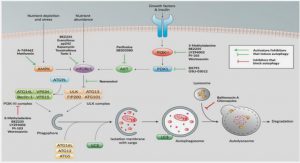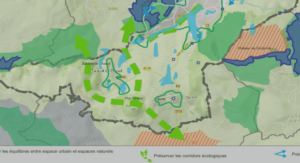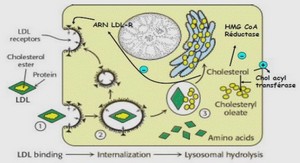Identification de processus d’épuration en jeu
Field study
The study site includes two stormwater biofilters: a vegetative filter strip (VFS, constructed in September 2012) and a biofiltration swale (BFS, constructed in March 2016), both of which evacuate water from the RD 212, a highway located in an industrial zone of Compans, France in the Paris region (Supplemental Information, Figure 76). At both sites, water was collected from a drain beneath the filter media (a mixture of 60% lime sand and 40% loam top soil by volume with a sandy loam texture) at depths of 15 and 50 cm for VFS and BFS, respectively. Only BFS is lined. Outlet water quality is compared to untreated road runoff (RR) collected at another section of the same road (Figure 65). Figure 65: Compans study site Flow proportional samples were collected using two refrigerated automatic samplers at RR and passive systems collecting a known fraction of each bucket tip at VFS and BFS. Sampling began in February 2016 for VFS and RR and in May 2016 for BFS and continued until July 2017 at all sites. Overall, 19 events were sampled during all four seasons, with 14, 15, and 18 samples collected for RR, BFS and VFS, respectively. While simultaneous sampling of all points was attempted, different starting dates and technical difficulties mean that not all data are paired. Samples were collected immediately following the end of runoff flow and sent the same day to partner laboratories, where they were immediately filtered to distinguish between dissolved and particulate phases. Sensors measuring water content continuously (EC-5 and EC-5 TE Rétention et devenir des micropolluants dans les ouvrages de biofiltration 204 from Decagon) were installed in the VFS (3 sensors above the sheet drain) and the BFS (15 sensors). Samples were analyzed for a range of global parameters and micropollutants (Tableau 50, for analytical methods see Tableau 56 in Supplementary Information). Phosphorus and Kjeldahl nitrogen were analyzed in the total and dissolved phases, while OC, metals, major ions and organic micropollutants were analyzed in the particulate and dissolved phases.
Estimation of partition coefficients
In order to compare field observations to expected behavior, pollutant partitioning coefficients (KD), were determined in the lab for a selection of pollutants: Zn, Cu, BPA, NP and OP by batch tests. All tests were carried out using Evian mineral water diluted 1:4 with ultrapure water, which provided a pH and EC similar to those observed in field conditions outside periods of de-icing salt application. Batch tests were conducted at several concentrations for each pollutant (Tableau 51). For each test, 5g of unused BFS filter media was equilibrated with 1 L of water for 24h. Following this period, a certain quantity of a given pollutant was added to reach the desired initial concentration; the system was then equilibrated by mixing constantly for 24h; a kinetic study Rétention et devenir des micropolluants dans les ouvrages de biofiltration 205 of each pollutant confirmed that equilibrium was reached during this duration. Water was filtered and analyzed for dissolved concentrations; the change in concentration was assumed to be sorbed to the media. The partition coefficient, KD, was evaluated using only the points in the linear range of the isotherm. NaN3 was included in the BPA, NP and OP batch solutions to inhibit biodegradation.
Characterization of trace metal leaching from sediment and polluted soil
In order to consider the potential for remobilization of trace metals, batch tests were also conducted using road sediments and polluted soil. Sediment was collected from the road surface, while polluted soil was collected at the surface of the VFS at a distance of 30cm from the road. Samples were collected in January 2016, dried, sieved, and homogenized before each experiment. As with sorption batch tests, all tests were carried out using Evian mineral water diluted 1:4 with ultrapure water. 5g of sediment or soil was equilibrated with 1L of water for 24h. Initial concentrations of the soil and sediment were measured as were concentrations in filtered water after equilibration; the change in water concentration was assumed to be due to desorption from soil or sediment. Initial soil concentrations, dissolved concentrations at equilibrium and resulting partition coefficients are presented in Tableau 53. Sediment Soil Cu Zn Cu Zn Sinitial (mg/kg) 302 766 235 806 CD,eq (mg/L) 0.0124 0.0134 0.0071 0.0102 KD (L/kg) 24190 56940 32958 78823 Tableau 53 : Conditions and results of trace metal desorption tests. Sinitial is the initial solid concentration, CD,eq is the dissolved concentration at equilibrium and KD is the partition coefficient.
Characterization of pollutant leaching from construction materials
Leaching of organic micropollutants from construction materials of the BFS (asphalt, drain, drain filter fabric and geomembrane) was also evaluated using batch tests. These tests were also carried out using Evian mineral water diluted 1:4 with ultrapure water. The drain, drain filter fabric and geomembrane samples employed for leaching tests had not been installed on site prior to the tests . However, the asphalt was collected on site a year after its installation. Materials were placed in contact with water and agitated constantly for 24h before being filtered and analyzed for BPA, alkylphenols and phthalates; PAHs were also analyzed for the asphalt and geomembrane tests. Concentrations were compared to a reference sample batch into which no material was introduced. All analyses were conducted in the dissolved phase only according to the same procedures as field samples, except that double the volume was extracted for PAH analysis to lower the limits of quantification. L/S ratios for leaching tests of the geomembrane, drain and drain fabric were selected to correspond to a low ratio that could be observed in situ, as would be observed for a small (~2 mm) rain event. As the catchment drained by the BFS (including its own surface and sideslopes) is about 12m wide, rain from a surface of about 12 m² is expected to be drained by each linear meter of the BFS. Assuming a runoff coefficient of about 0.8, about 20L of runoff is expected to reach the BFS per linear meter. Therefore, 1L of water would be in contact with about 5 cm of each material. Therefore, 5 cm of the agricultural drain and fabric were put in contact with 1L of water. It was assumed that mainly the 50 cm width of geomembrane at the bottom of the BFS would be in Rétention et devenir des micropolluants dans les ouvrages de biofiltration 207 contact with water; 500 cm² of geomembrane was thus put in contact with 2L of water. Both the agricultural drain and then geomembrane were cut into pieces (each approximately 2-3 cm²) to ensure their contact with water. As the asphalt was collected on site a year after its installation, it was broken into pea-sized pieces before being put in contact with water to ensure that virgin surfaces were exposed. With this modified surface area, no clear relationship existed between a quantity of asphalt and water. The choice was made to put 200g of asphalt in contact with 2L of water.



